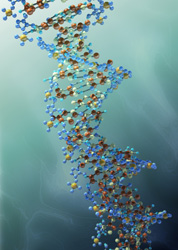Breaks in DNA give scientists breakthrough
Single-strand break repair (SSBR) is vital for cell survival and maintaining genome stability. Better understanding how SSBR takes place and what can hinder it will shed light on the molecular bases of some neurodegenerative diseases, such as spinocerebellar ataxia-1 (SCAN-1). The 'Molecular analysis of single-strand break repair (SSBR) in human cells' (SSB repair) project aimed to study the molecular mechanisms taking place in SSB repair. So it attempted to set up a system to induce site-specific SSB in human cells. Researchers believed this would allow for direct analysis of the assembly/disassembly of protein complexes during SSB reaction as well as give the means of measuring the actual repair event. Results rendered it impossible to detect SSB induction. The project partners noted that the levels of induction were too low for detection and therefore could not be used for the intended analysis. This shifted the team's interest to examining the role of new SSBR components discovered during the study. The researchers identified APLF (aprataxin and PNK-like factor), involved in protein coding, as an element in DNA strand break repair reactions. The work revealing that APLF depletion leads to gaps in normal single- and double-strand break repair processes was published in the journal Molecular and Cellular Biology in 2008. SSB repair also searched for new SSBR genes, focusing on the repair of Top1-mediated SSB lesions. These are a special type of SSB and an important source of internal DNA damage. It has been found that the repair of this is impaired in SCAN1 by a mutation in the TDP1 (tyrosyl-DNA phosphodiesterase 1) enzyme. Employing existing knowledge in genetics and biochemistry, subsequent work identified TTRAP: this is basically a 5'-TDP, whose activity can facilitate the repair of double-strand breaks. This is the first time it has been identified in human cells. On the strength of these findings, TTRAP is now officially denoted by the Human Genome Organisation (HUGO) as TDP2. This work was published in the journal Nature in 2009.







